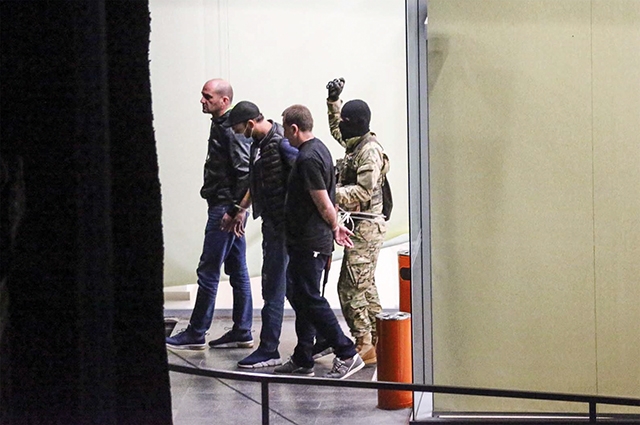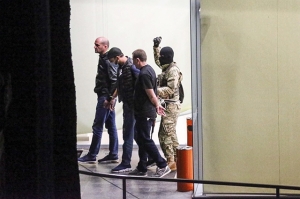What Went Wrong: Zugdidi is a “Black Eye” for Georgia
OP-ED
Georgia had its eyes glued to the television last Wednesday when a man, equipped for war, took control of a branch of the Bank of Georgia in Zugdidi. While many in the West might see this as just a bad day, for Georgians this is an extreme outlier. For hours, the armed man made demands and kept police units at bay, even firing his weapon, and ultimately maintaining total control of the situation. Initially, police responded in a timely and hasty manner with a common law enforcement tactic: contain the issue and monitor so as to develop a base of intelligence on the suspect. However, the Ministry of Internal Affairs proceeded to make some of the largest mistakes any police force could make.
In the early afternoon of Wednesday, October 21, a man kitted with a small backpack, MultiCam uniform with a Georgian flag patch and army insignia, a chest carrier with magazines and grenades, and an AKS-74, chambered in the 5.45x39 millimeter cartridge, entered the Bank of Georgia office on Zviad Gamsakhurdia Avenue, Zugdidi. After firing several rounds as a sign of domination, he ordered the people to the ground, and immediately subjugated the patrons and employees.
Naturally, local police elements responded in earnest. However, despite modern protocol for active shooter situations used by western law enforcement, they merely sat outside and watched the man control everything. After the horror of the Columbine High School in the United States in the 1990s and the subsequent recurring issue of active shooter situations, virtually all law enforcement changed police response tactics to an active interdiction doctrine. This doctrine pushed officers to form teams and immediately engage and eliminate attackers so as to reduce their tactical initiative, limit any further casualties, and end the situation as fast as possible by restoring the rule of law and order.
With active shooter situations taking to the stage the world over, law enforcement has largely countered this with similar aggressive tactics. Whereas the standard policy was to stand by for tactical teams and negotiators, the responding officers are now to engage, corner, and preferably arrest or, if required, eliminate the perpetrator. This training became mainstream in the early 2000s. Now, United States and European police forces do not limit the advanced Close Quarters Combat (CQC) training to special teams, but to all officers in the field.
The new program, dubbed ‘Immediate Action Rapid Deployment’ (IARD) is a training program aimed at getting police officers that are the first to respond to counter with equal force. Ideally, a 4 to 8 officer team would immediately enter the location and engage the attacker. Part of this training was to even pass wounded victims and other dangers such as small fires, so as to halt the threat at all costs, and allow supporting elements, known as “trailers,” which include fire and medical personnel, to care for the wounded or deal with environmental hazard issues. These tactics have proven highly successful in active shooter situations to date.
The police that arrived that day in Zugdidi failed in this. The attacker was afforded every opportunity to dominate the situation, influence the media, and even barricade himself so as to prevent a police assault. He was even allowed to broadcast vicariously from his position and deliver messages to the public via the media. At no point were the police prepared to eliminate the threat. In addition, despite the building being predominantly glass on the street-facing sides and exposing himself innumerable times, no police precision marksman unit engaged.
As a result of a complete abortion of law enforcement duties and responsibilities, the man, now identified as Badri Esebua, was able to manipulate police and bargain for his escape. A former soldier in the Georgian defense forces, he knew he could play them like an instrument. According to a recent GEORGIA TODAY piece, Esebua served in the 2nd Infantry Brigade, and as a result likely had at a minimum a basic understanding of area capture and defense techniques. Georgian police, slow to adopt the advanced tactics and techniques of the west, paid the price not only in a loss of professional appearance but also as a lesson that they are not the strong entity they make themselves out to be. Georgian police have long been viewed as a symbol of pride since the 2005 reforms, even gaining acclamation from European partner entities.
After the incident, the police proceeded to further disgrace their office by letting the man go free. While he may have been armed and potentially handling a live F-1 fragmentation grenade, the issue stands that he was let free, and not tracked. Now, while the remaining three hostages he kept with him have been released, the police are still fumbling in the dark for the man that made a mockery of them.
This situation clearly calls for a reformation and modernization on counterterrorism and active shooter tactics. While Georgia has been blessed by a broad peace in the realm of crime, particularly in gun crime and terrorism, this comes as a wakeup call. As is commonly said amongst soldiers stationed overseas for long periods of time, during long periods where combat is scarce, “complacency kills.”
Despite their continued work against narcotics and petty crime in the country, the preparedness of the everyday officers should never be left to the wayside. Police serve in one of the most important day-to-day jobs of any community, and part of that is being prepared to serve their people in any capacity, even if that means engaging terrorists face-to-face, gun to gun, and win every time. Having been in these situations myself, many times, I understand this is often something that is easier said than accomplished. More advanced training at the individual and patrol officer team level, as well as equipping officers for these difficult situations, should not be overlooked. Thankfully, no innocent lives were lost, or severe injuries sustained. However, should there be a “next time” the same mistakes cannot be repeated.
By Michael Godwin
Image source: AP












